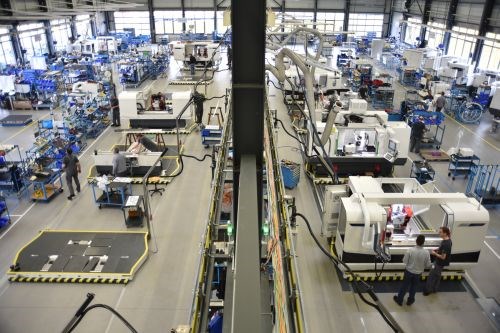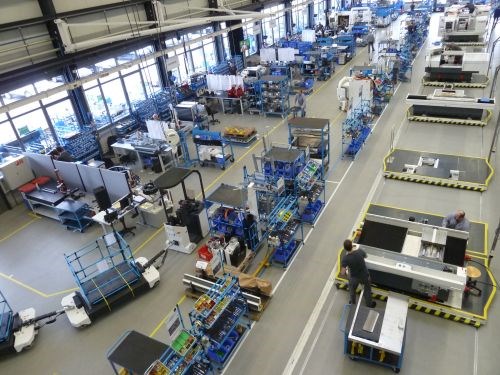New Super-Efficient Assembly Line Improves Productivity, Flexibility
Studer’s assembly line moves machines forward through 16 workstations without requiring them to be relocated for additional operations, including test grinding.

I recently had the opportunity to attend the 2016 Motion Meeting at United Grinding Group’s Studer facility in Thun, Switzerland (see the blog post and slideshow). As one of the first trade editors to witness the line in production—it was under construction for more than three years—I was impressed by the flow and efficiency of the process. Here is a list of some details Studer representatives shared with me.
According to the company, the Flow-Assembly+ process incorporates all manufacturing operations for the entire Studer product portfolio into one assembly line, enhancing the company’s ability to quickly meet specific customer demands and delivery requirements. The process divides assembly for Studer internal and external cylindrical grinding machine into 16 stations, which are arranged in a U shape. On the first side of the U, a normal rail system is used. On the second side—where the laser measurement and test grinding of the machine in motion take place—there is a high-precision conveyor system that is approximately 130 feet in length, which corresponds to a large, high-precision machine tool guide.
The 16 stations are divided into four segments, in which as many as four employees per station assemble the complex machines. The line is designed for a single-shift system, with two four-hour sessions and runs continuously for four hours at a speed of 1.375 miles per hour. The line is currently set up to produce two machines a day, with the flexibility to increase output as demand grows.
With the Flow-Assembly+ process, machines are ready for delivery to customers once they have passed the last station in the line. Design modifications such as special, in-process gaging systems or customer-specific clamping systems, as well as laser measurement and test grinding, are integrated into the flow. To further enhance productivity, the required assembly parts are delivered to the line just in time and directly from the warehouse, partly via Kanban. Every four hours, material is delivered for the next four hours, including the provision of all necessary parts and tools.
Prior to implementation of Flow-Assembly+ in October of last year, Studer used fixed-station and non-continuous paced assembly for production. Implementation of the new process is a result of the company’s PuLs continuous development and improvement program.
I found the entire project to be proof of the company’s commitment to continuous improvement and the desire to serve its markets and customers well.

Assembly parts are delivered to the line just in time and directly from the warehouse, partly via Kanban. Every four hours, material is delivered for the next four hours.
Related Content
-
Automation Breakthroughs Revolutionize Precision Machining for Complex Parts
Marubeni Citizen-Cincom delivers custom solutions to address some of the biggest challenges in precision machining from handling small parts, to robot integration and unique tooling needs.
-
High-Volume Machine Shop Automates Secondary Ops
An Ohio contract shop added a compact, self-loading CNC lathe to perform unattended secondary ops on a part for a key customer rather than running it on a manually loaded chucker.
-
Inside the Premium Machine Shop Making Fasteners
AMPG can’t help but take risks — its management doesn’t know how to run machines. But these risks have enabled it to become a runaway success in its market.











.jpg;maxWidth=300;quality=90)



